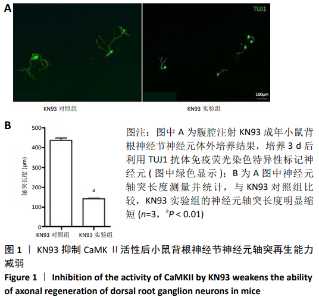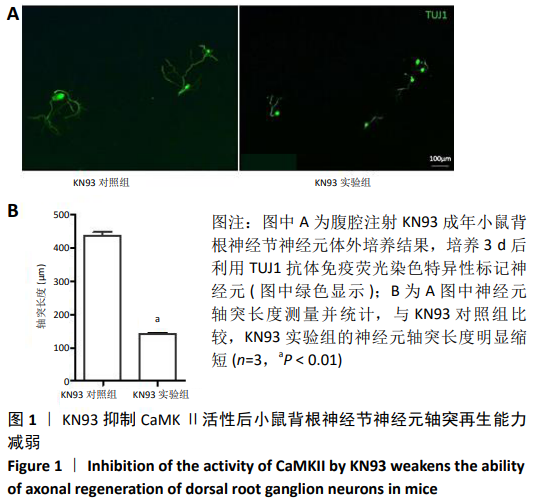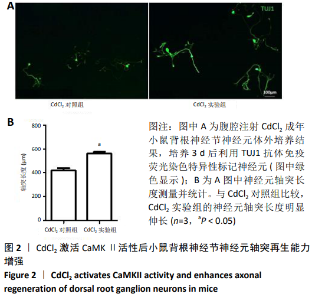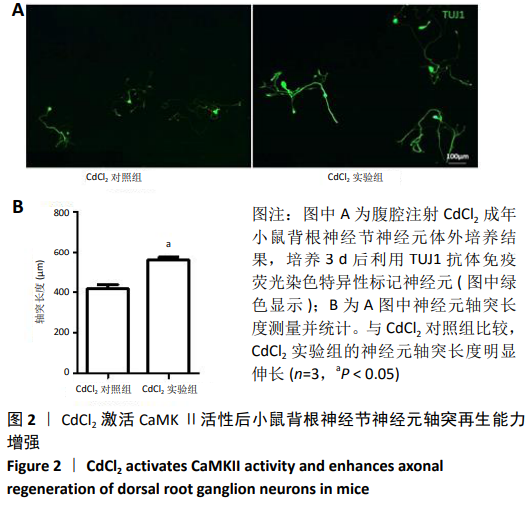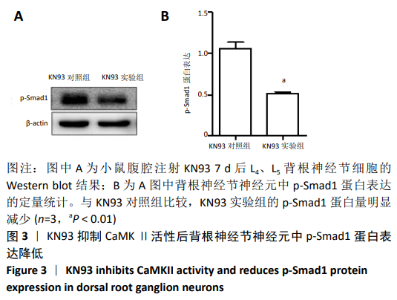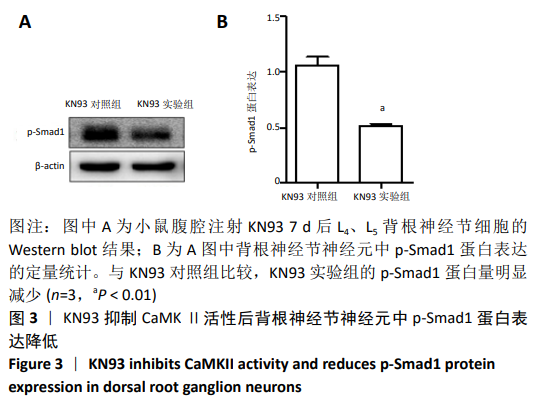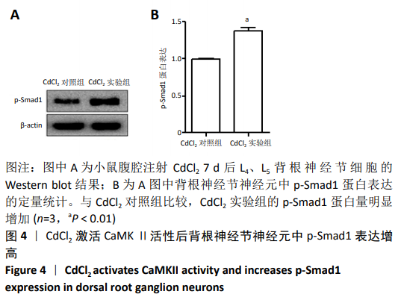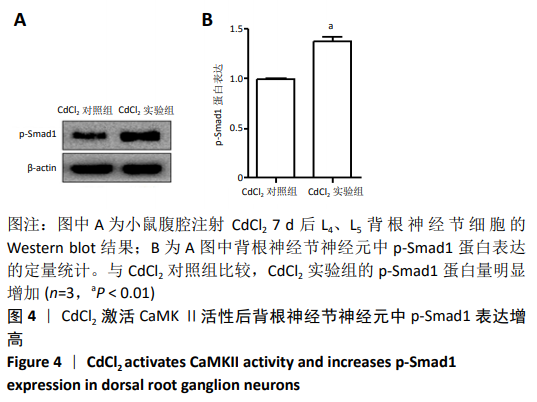Chinese Journal of Tissue Engineering Research ›› 2021, Vol. 25 ›› Issue (7): 1064-1068.doi: 10.3969/j.issn.2095-4344.2173
Previous Articles Next Articles
CaMKII-Smad1 promotes axonal regeneration of peripheral nerves
Wang Feng1, 2, Zhou Liyu2, Saijilafu1, Qi Shibin1, 2, Ma Yanxia1, Wei Shanwen1, 2
- 1Institute of Orthopedics, Medical College of Soochow University, Suzhou 215000, Jiangsu Province, China; 2Department of Orthopedics, First Affiliated Hospital of Soochow University, Suzhou 215006, Jiangsu Province, China
-
Received:2020-01-22Revised:2020-01-22Accepted:2020-04-11Online:2021-03-08Published:2020-12-08 -
Contact:Wei Shanwen, Master, Institute of Orthopedics, Medical College of Soochow University, Suzhou 215000, Jiangsu Province, China; Department of Orthopedics, First Affiliated Hospital of Soochow University, Suzhou 215006, Jiangsu Province, China -
About author:Wang Feng, Master, Experimentalist, Institute of Orthopedics, Medical College of Soochow University, Suzhou 215000, Jiangsu Province, China; Department of Orthopedics, First Affiliated Hospital of Soochow University, Suzhou 215006, Jiangsu Province, China -
Supported by:the National Natural Science Foundation of China (General Program), No. 81571189
CLC Number:
Cite this article
Wang Feng, Zhou Liyu, Saijilafu, Qi Shibin, Ma Yanxia, Wei Shanwen. CaMKII-Smad1 promotes axonal regeneration of peripheral nerves[J]. Chinese Journal of Tissue Engineering Research, 2021, 25(7): 1064-1068.
share this article
| [1] ABANKWA D, KÜRY P, MÜLLER HW. Dynamic changes in gene expression profiles following axotomy of projection fibres in the Mammalian CNS. Mol Cell Neurosci. 2002;21(3):421-435. [2] SILVER J, SCHWAB ME, POPOVICH PG. Central nervous system regenerative failure: role of oligodendrocytes, astrocytes, and microglia. Cold Spring Harb Perspect Biol. 2014;7(3):a020602. [3] FILBIN MT. Recapitulate development to promote axonal regeneration: good or bad approach? Philos Trans R Soc Lond B Biol Sci. 2006;361 (1473):1565-1574. [4] GOLDBERG JL, KLASSEN MP, HUA Y, et al. Amacrine-signaled loss of intrinsic axon growth ability by retinal ganglion cells. Science. 2002; 296 (5574):1860-1864. [5] SCHWAB ME, BARTHOLDI D. Degeneration and regeneration of axons in the lesioned spinal cord. Physiol Rev. 1996;76(2):319-370. [6] LEE JK, GEOFFROY CG, CHAN AF, et al. Assessing spinal axon regeneration and sprouting in Nogo-, MAG-, and OMgp-deficient mice. Neuron. 2010;66(5):663-670. [7] SILVER J, MILLER JH. Regeneration beyond the glial scar. Nat Rev Neurosci. 2004;5(2):146-156. [8] HAMMARLUND M, NIX P, HAUTH L,et al. Axon regeneration requires a conserved MAP kinase pathway. Science. 2009;323(5915):802-806. [9] NIX P, HISAMOTO N, MATSUMOTO K, et al. Axon regeneration requires coordinate activation of p38 and JNK MAPK pathways. Proc Natl Acad Sci U S A. 2011;108(26):10738-10743. [10] FAAS GC, RAGHAVACHARI S, LISMAN JE, et al. Calmodulin as a direct detector of Ca2+ signals. Nat Neurosci. 2011;14(3):301-304. [11] AVERSA Z, ALAMDARI N, CASTILLERO E, et al. CaMKII activity is reduced in skeletal muscle during sepsis. J Cell Biochem. 2013;114(6): 1294-1305. [12] YAMAUCHI T, FUJISAWA H. Evidence for three distinct forms of calmodulin-dependent protein kinases from rat brain. FEBS Lett. 1980; 116(2):141-144. [13] KENNEDY MB, GREENGARD P. Two calcium/calmodulin-dependent protein kinases, which are highly concentrated in brain, phosphorylate protein I at distinct sites. Proc Natl Acad Sci U S A. 1981;78(2): 1293-1297. [14] PENG J, KIM MJ, CHENG D, et al. Semiquantitative proteomic analysis of rat forebrain postsynaptic density fractions by mass spectrometry. J Biol Chem. 2004;279(20):21003-21011. [15] COLBRAN RJ, SODERLING TR. Calcium/calmodulin-dependent protein kinase II. Curr Top Cell Regul. 1990;31:181-221. [16] KELLY PT. Calmodulin-dependent protein kinase II. Multifunctional roles in neuronal differentiation and synaptic plasticity. Mol Neurobiol. 1991;5(2-4):153-177. [17] KENNEDY MB, BENNETT MK, BULLEIT RF, et al. Structure and regulation of type II calcium/calmodulin-dependent protein kinase in central nervous system neurons. Cold Spring Harb Symp Quant Biol. 1990;55:101-110. [18] YAMAUCHI T, FUJISAWA H. Disassembly of microtubules by the action of calmodulin-dependent protein kinase (Kinase II) which occurs only in the brain tissues. Biochem Biophys Res Commun. 1983;110(1):287-291. [19] ZOU H, HO C, WONG K, et al. Axotomy-induced Smad1 activation promotes axonal growth in adult sensory neurons. J Neurosci. 2009; 29(22):7116-7123. [20] SAIJILAFU, HUR EM, LIU CM, et al. PI3K-GSK3 signalling regulates mammalian axon regeneration by inducing the expression of Smad1. Nat Commun. 2013;4:2690. [21] FINELLI MJ, MURPHY KJ, CHEN L, et al. Differential phosphorylation of Smad1 integrates BMP and neurotrophin pathways through Erk/Dusp in axon development. Cell Rep. 2013;3(5):1592-1606. [22] FARRUKH F, DAVIES E, BERRY M, et al. BMP4/Smad1 signalling promotes spinal dorsal column axon regeneration and functional recovery after injury. Mol Neurobiol. 2019;56(10):6807-6819. [23] FORMAN DS, MCQUARRIE IG, LABORE FW, et al. Time course of the conditioning lesion effect on axonal regeneration. Brain Res. 1980; 182(1):180-185. [24] PARIKH P, HAO Y, HOSSEINKHANI M, et al. Regeneration of axons in injured spinal cord by activation of bone morphogenetic protein/Smad1 signaling pathway in adult neurons. Proc Natl Acad Sci U S A. 2011;108(19):E99-107. [25] YAN D, WU Z, CHISHOLM AD, et al. The DLK-1 kinase promotes mRNA stability and local translation in C. elegans synapses and axon regeneration. Cell. 2009;138(5):1005-1018. [26] PASTUHOV SI, FUJIKI K, NIX P, et al. Endocannabinoid-Goα signalling inhibits axon regeneration in Caenorhabditis elegans by antagonizing Gqα-PKC-JNK signalling. Nat Commun. 2012;3:1136. [27] BANGARU ML, MENG J, KAISER DJ, et al. Differential expression of CaMKII isoforms and overall kinase activity in rat dorsal root ganglia after injury. Neuroscience. 2015;300:116-127. [28] LIU Y, TEMPLETON DM. Initiation of caspase-independent death in mouse mesangial cells by Cd2+: involvement of p38 kinase and CaMK-II. J Cell Physiol. 2008;217(2):307-318. [29] AFSHARI FT, KAPPAGANTULA S, FAWCETT JW. Extrinsic and intrinsic factors controlling axonal regeneration after spinal cord injury. Expert Rev Mol Med. 2009;11:e37. [30] GIGER RJ, HOLLIS ER 2ND, TUSZYNSKI MH. Guidance molecules in axon regeneration. Cold Spring Harb Perspect Biol. 2010;2(7):a001867. [31] FILBIN MT. Myelin-associated inhibitors of axonal regeneration in the adult mammalian CNS. Nat Rev Neurosci. 2003;4(9):703-713. [32] CHANDRAN V, COPPOLA G, NAWABI H, et al. A Systems-Level Analysis of the Peripheral Nerve Intrinsic Axonal Growth Program. Neuron. 2016;89(5):956-970. [33] DANILOV CA, STEWARD O. Conditional genetic deletion of PTEN after a spinal cord injury enhances regenerative growth of CST axons and motor function recovery in mice. Exp Neurol. 2015;266:147-160. [34] ZUKOR K, BELIN S, WANG C, et al. Short hairpin RNA against PTEN enhances regenerative growth of corticospinal tract axons after spinal cord injury. J Neurosci. 2013;33(39):15350-15361. [35] HUANG Z, HU Z, XIE P, et al. Tyrosine-mutated AAV2-mediated shRNA silencing of PTEN promotes axon regeneration of adult optic nerve. PLoS One. 2017;12(3):e0174096. [36] EASLEY CA, FAISON MO, KIRSCH TL, et al. Laminin activates CaMK-II to stabilize nascent embryonic axons. Brain Res. 2006;1092(1):59-68. [37] TANG F, KALIL K. Netrin-1 induces axon branching in developing cortical neurons by frequency-dependent calcium signaling pathways. J Neurosci. 2005;25(28):6702-6715. [38] JOURDAIN P, FUKUNAGA K, MULLER D. Calcium/calmodulin-dependent protein kinase II contributes to activity-dependent filopodia growth and spine formation. J Neurosci. 2003;23(33):10645-10649. |
| [1] | Li Jing, Xie Jianshan, Cui Huilin, Cao Ximei, Yang Yanping, Li Hairong. Expression and localization of diacylglycerol kinase zeta and protein kinase C beta II in mouse back skin with different coat colors [J]. Chinese Journal of Tissue Engineering Research, 2021, 25(8): 1196-1200. |
| [2] | Chen Jiming, Wu Xiaojing, Liu Tianfeng, Chen Haicong, Huang Chengshuo. Effects of silymarin on liver injury and bone metabolism induced by carbon tetrachloride in mice [J]. Chinese Journal of Tissue Engineering Research, 2021, 25(8): 1224-1228. |
| [3] | Zhu Xuefen, Huang Cheng, Ding Jian, Dai Yongping, Liu Yuanbing, Le Lixiang, Wang Liangliang, Yang Jiandong. Mechanism of bone marrow mesenchymal stem cells differentiation into functional neurons induced by glial cell line derived neurotrophic factor [J]. Chinese Journal of Tissue Engineering Research, 2021, 25(7): 1019-1025. |
| [4] | Zhang Mi, Wu Saixuan, Dong Ming, Lu Ying, Niu Weidong. Expression of interleukin-24 in a mouse model of periapical periodontitis [J]. Chinese Journal of Tissue Engineering Research, 2021, 25(5): 679-684. |
| [5] | Xie Yang, Zhang Shujiang, Liu Menglan, Luo Ying, Yang Yang, Li Zuoxiao. Mechanism by which rapamycin protects spinal cord neurons in experimental autoimmune encephalomyelitis mice [J]. Chinese Journal of Tissue Engineering Research, 2021, 25(5): 695-700. |
| [6] | Xie Yang, Lü Zhiyu, Zhang Shujiang, Long Ting, Li Zuoxiao. Effects of recombinant adeno-associated virus mediated nerve growth factor gene transfection on oligodendrocyte apoptosis and myelination in experimental autoimmune encephalomyelitis mice [J]. Chinese Journal of Tissue Engineering Research, 2021, 25(23): 3678-3683. |
| [7] | Yang Xinhua, Yan Yindi, Luo Xuguang, Yang Yanping, Li Hairong, Cui Huilin, Cao Ximei. Bmal1 and Clock regulate the development and differentiation of skeletal muscle [J]. Chinese Journal of Tissue Engineering Research, 2021, 25(20): 3130-3137. |
| [8] | Li Zhen, Huang Yonghui, Sun Jifu, Sun Haitao. Role and mechanism of focal adhesion kinase in inducing osteogenic differentiation of mouse embryonic fibroblasts cells [J]. Chinese Journal of Tissue Engineering Research, 2021, 25(2): 165-171. |
| [9] | Geng Bin, Xia Yayi. Involvement of ERK5 signaling pathway in osteoporosis development in mice [J]. Chinese Journal of Tissue Engineering Research, 2021, 25(2): 178-185. |
| [10] | Li Xiaoqun, Xu Kaihang, Ji Fang. Corylin inhibits osteoclastogenesis and attenuates postmenopausal osteoporosis in mice [J]. Chinese Journal of Tissue Engineering Research, 2021, 25(2): 186-190. |
| [11] | Zhang Xiang, Zhang Yeting. Exercise improves progression of Alzheimer’s disease in mice: a dose-effect relationship [J]. Chinese Journal of Tissue Engineering Research, 2021, 25(17): 2761-2766. |
| [12] | Yang Fan, Liu Baoyi, Liu Jiahe, Yang Jiahui, Qin Kairong, Zhao Dewei. Morphological characteristics of in vitro cultured articular chondrocytes from Sprague-Dawley rats at passage number from 0 to 3 [J]. Chinese Journal of Tissue Engineering Research, 2021, 25(14): 2161-2165. |
| [13] | Li Hang, Jing Ya, Li Yunhua, Li Hairong, Yang Yanping. A downtrend of mesenchymal cells derived from the second heart field and cardiac neural crest in the outflow tract of Cx43 knockout embryonic mouse heart [J]. Chinese Journal of Tissue Engineering Research, 2021, 25(13): 2018-2024. |
| [14] | Yan Nan, Si Xiaofeng, Zeng Liang, Tian Wei, Shan Guangdong, Xiong Lishuo, Yang Weijie, Wang Zhengdong. Nerve growth factor interferes with proliferation and alpha-actin expression of skeletal muscle satellite cells in rats [J]. Chinese Journal of Tissue Engineering Research, 2021, 25(13): 2030-2035. |
| [15] | Xu Jinhui, Qin Xuzhen, Zhang Hongcheng, Ma Yanxia, Qi Shibin, Saijilafu. Difference in the culture of dorsal root ganglion cells in serum-free medium and serum medium [J]. Chinese Journal of Tissue Engineering Research, 2021, 25(13): 2043-2048. |
| Viewed | ||||||
|
Full text |
|
|||||
|
Abstract |
|
|||||
